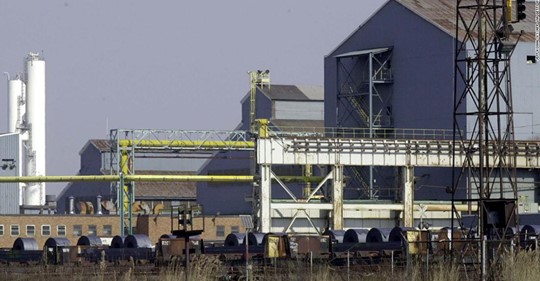
On December 20, 2019, Chris Isidore writes on CNN Business:
US Steel is closing a mill near Detroit, laying off workers and cutting its dividend. The troubled company is trying to reverse operating losses it now forecasts for the fourth quarter.
The mill, called the Great Lakes Works, is expected to close its iron and steelmaking operations by April 1. The part of the mill that rolls slabs into sheets of steel will shutter by the end of next year. About 1,500 jobs will be lost, the company said. US Steel had already announced a temporary layoff of about 200 workers at the plant earlier this year.
The company may keep some adjoining operations and a warehouse open if justified by customer demand, it said. But it will shift the steel production to a plant in Gary, Indiana, where it recently made a $750 million investment.
“We are conscious of the impact this decision will have on our employees, their families, and the local community, and we are announcing it now to provide them with as much time as possible to prepare for this transition,” said CEO David Burritt. “These decisions are never easy, nor are they taken lightly.”
The company said it will focus its operations making sheets of steel at three other mills. One is a mill outside of Pittsburgh, where it is in the process of a $1 billion upgrade to a more efficient casting operation. The other mills are the mill in Gary and Big River Steel, an Arkansas company it is in the process of purchasing. It is also remaining in the steel tube business, in which it recently invested $280 million on an Alabama electric furnace to melt steel scrap into new steel products. But in addition to the layoffs and the dividend cut, the company plans to cut its capital spending plans by $75 million in 2020. It also expects other cost cuts, including labor costs, to save an additional $75 million.
“In order to further accelerate our strategy of creating a world-competitive…US Steel, we must make deliberate but difficult operational decisions. In this case, current market conditions and the long-term outlook for Great Lakes Works made it imperative that we act now, allowing us to better align our resources to deliver cost or capability differentiation across our footprint,” said Burritt.
The company and the rest of the domestic steel industry were supposed to get help from a 25% tariff on steel imports put in place in 2018 by the Trump administration. But after a short-term rise in steel prices, they have retreated and problems have returned to the industry. In October US Steel reported its first loss since tariffs were imposed.
Peter Navarro, the White House’s director of the office of trade and manufacturing policy, told CNN Friday that the layoffs and closing of the US Steel mill were a sign of problems at the company, and not the tariffs or US trade policy.”
I think the bet [on tariffs] is paying off beautifully,” he said. “We are very bullish on the steel and aluminum industries because of the tariffs. If they weren’t in place, those industries would be in very bad shape right now.”
As far as US Steel’s situation, Navarrow said the company “did not adapt with the times. They are paying for it dearly.”
The company also announced it is cutting its dividend by 80% to 1 cent a share. And after previously announcing it would suspend share repurchases, it announced Thursday that it was formally ending its share repurchase program. Shares of US Steel (X) were down 8% in early trading Friday, leaving shares down 32% for the year.
https://www.cnn.com/2019/12/20/business/us-steel-mill-closing/index.html
Gary Reber Comments:
The controlling owners of corporations will always have the say as to what is the status of their capital assets. In this case, the controlling owners of US Steel are moving production to upgraded “machine” productive capability Pennsylvania and Arkansas.
Strong tariffs need to be applicable to EVERY country seeking to penetrate and displace our own homeland steel productive capabilities. At the same time, our industries must adopt the most technically sophisticated, advanced and efficient “machine” automation manufacturing to produce competitively.
What is critical is that employees and citizens become new owners of plant and machinery capital asset improvements and new production capabilities.
At present, employees and ordinary Americans are not the owners, which instead is concentrated among a small wealthy capital asset ownership class. Employees and the vast majority of Americans are solely dependent on their ability to earn as a labor worker, being excluded from becoming a capital “worker” and earning a second income and eventually a primary income from the earnings of their productive capital assets.

